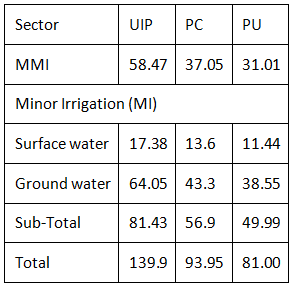Irrigation Projects - 2 | NABARD Grade A & Grade B Preparation - Bank Exams PDF Download
Major, Medium and Minor Irrigation Projects - Potential Created and Utilized
The demand for irrigation water in India is substantial, but the capacity for storing and transferring water places limitations on the potential for irrigation. It is necessary to periodically reassess the Ultimate Irrigation Potential (UIP) to account for changes in scope, technological advancements, inter-basin water transfers, induced groundwater recharge, and other factors. The projects covered under the Accelerated Irrigation Benefit Program (AIBP) have an Ultimate Irrigation Potential (UIP) estimated at approximately 139.9 million hectares. Details regarding Potential Created (PC) and Potential Utilized (PU) up to the end of the Ninth Plan can be found in Table 3.2.
Table 3.2: Sector wise UIP, PC and PU Till end of IXth Plan (in Mha)
Procedure for Setting up a MMI Project in India
When a state intends to initiate a new irrigation project, it must follow the "Guidelines for Submission, Appraisal, and Clearance of Irrigation and Multipurpose Projects" issued by the Central Water Commission (CWC). The state planning to undertake this project should prepare a detailed report, which must be submitted to the project appraisal organization within the CWC for clearance.
This report should include certification of the following:
- Confirmation that all essential surveys and investigations, as per specified guidelines, have been conducted to plan the proposed irrigation project and determine its economic viability.
- Detailed investigations covering 10% of the command area of the proposed project, divided into three representative patches, to estimate the conveyance system up to the last farm outlets.
- Thorough investigation of 10% of the canal structures.
- Comprehensive hydrological, geological, and construction material investigations for all major structures, such as dams, weirs, main canals, branch canals, and distributaries with a discharge of 10 m³/s.
- Soil survey of the command area in accordance with IS 5510-1969.
- Designing of the various project components in compliance with guidelines and relevant Indian standards.
- Conducting necessary studies on groundwater utilization, particularly addressing issues like waterlogging, and making provisions for the combined use of groundwater and drainage arrangements.
- Ensuring that cost estimates and economic evaluations adhere to the CWC's guidelines.
For multipurpose projects where irrigation is a component, a similar report is required. Additionally, the project report should be reviewed by a state-level project appraisal/technical advisory committee, comprising representatives from various departments including irrigation, agriculture, fisheries, forests, soil conservation, groundwater, revenue, finance, and state environmental management authority. The techno-economic feasibility report should also be supplemented with an "Environmental Impact Assessment Report" and a "Relief and Rehabilitation Plan," given the significant environmental impact of an irrigation project.
The project proposal submitted to the CWC will be examined by the members of the advisory committee within the Ministry of Water Resources. Once the project is deemed acceptable, it will be recommended for investment clearance to the Planning Commission and for inclusion in the five-year plan/annual plan.
Environmental Impact of Irrigation Projects
All water resource projects, whether they are intended for purposes like irrigation, hydroelectric power generation, flood control, or water supply, are constructed with the aim of benefiting human well-being. However, they inevitably have a significant impact on the surrounding ecosystems and the environment. When these projects are well-planned and appropriately designed, their adverse effects can be minimized. Environmental assessment or evaluation typically occurs during the project's planning and design phases. It is essential to create a comprehensive checklist of potential impacts and establish an environmental evaluation system to quantify the effects of irrigation projects.
The main objective of this assessment is to ensure that decision-makers take into account the environmental consequences of a project when determining whether to proceed with it or not. The International Association for Impact Assessment (IAIA) defines an environmental impact assessment (EIA) as "the process of identifying, predicting, evaluating, and mitigating the physical, social, and other pertinent effects of development proposals before making major decisions and commitments." EIAs are distinctive in that they don't mandate a predetermined environmental outcome but require decision-makers to consider environmental values in their choices and justify those decisions based on comprehensive environmental studies and public input concerning the potential environmental impacts of the proposal.
|
847 videos|1297 docs|420 tests
|
















